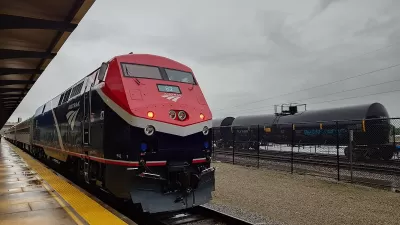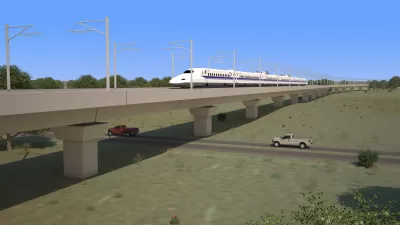This past Wednesday, Amtrak debuted the newest high-speed rail service in the country, and the first outside of the northeast corridor. Where you ask? California? Florida? Nope, it's is Kalamazoo, Michigan.
You want the scoop? First, the sloganeering, courtesy of Transportation Secretary Ray LaHood, "Now, Michigan and Indiana residents are the first to see the progress we've made on America's 21st century rail system. On Wednesday, Federal Railroad Administrator Joe Szabo joined Michigan DOT and Amtrak officials to ride the train between Chicago and Kalamazoo. And this was no ordinary ride. It marked the beginning of 110 miles-per-hour service between these two cities and the first expansion of regional high-speed rail outside the Northeast Corridor.
Now the messy reality, courtesy of Mark Brown, who reports that the famous Silver Streak train used to travel between Denver and Chicago at top speeds of 112.5 miles per hour -- in 1934! Furthermore, "Surprising to me, though, the 110-mph speeds take only 10 minutes off the one-way trip, officials said. That's because trains on the route were already going as fast as 95 mph before the most recent improvements that involved installing a high-tech train control system."
Hopefully this is just the first step in a decades-long process of expanding rail access and speeds across the country. And, in a bit of good news concerning this specific line, that both sources can agree on, "Within the next three years, Amtrak will expand 110 miles-per-hour service from Kalamazoo to the central and eastern regions of Michigan. Once complete, the modernized service will cut nearly two hours from the Detroit-Chicago run."
FULL STORY: Speeding to Kalamazoo aboard Amtrak’s high-speed train

Manufactured Crisis: Losing the Nation’s Largest Source of Unsubsidized Affordable Housing
Manufactured housing communities have long been an affordable housing option for millions of people living in the U.S., but that affordability is disappearing rapidly. How did we get here?

Americans May Be Stuck — But Why?
Americans are moving a lot less than they once did, and that is a problem. While Yoni Applebaum, in his highly-publicized article Stuck, gets the reasons badly wrong, it's still important to ask: why are we moving so much less than before?

Using Old Oil and Gas Wells for Green Energy Storage
Penn State researchers have found that repurposing abandoned oil and gas wells for geothermal-assisted compressed-air energy storage can boost efficiency, reduce environmental risks, and support clean energy and job transitions.

Minneapolis Bans Rent-Setting Software
Four cities have enacted restrictions on algorithmic software that can inflate rent costs.

Oakland to Add 244 New EV Chargers
Oakland plans to launch its new charging network at eight locations by the end of 2025.

Jane Goodall Inspires with Message of Hope, Resilience, and Environmental Action
Speaking in Pasadena, Jane Goodall offered a hopeful and inspirational message, urging global compassion, environmental responsibility, and the power of individual action to shape a better future.
Urban Design for Planners 1: Software Tools
This six-course series explores essential urban design concepts using open source software and equips planners with the tools they need to participate fully in the urban design process.
Planning for Universal Design
Learn the tools for implementing Universal Design in planning regulations.
Heyer Gruel & Associates PA
City of Moreno Valley
Institute for Housing and Urban Development Studies (IHS)
City of Grandview
Harvard GSD Executive Education
Salt Lake City
NYU Wagner Graduate School of Public Service
City of Cambridge, Maryland





























